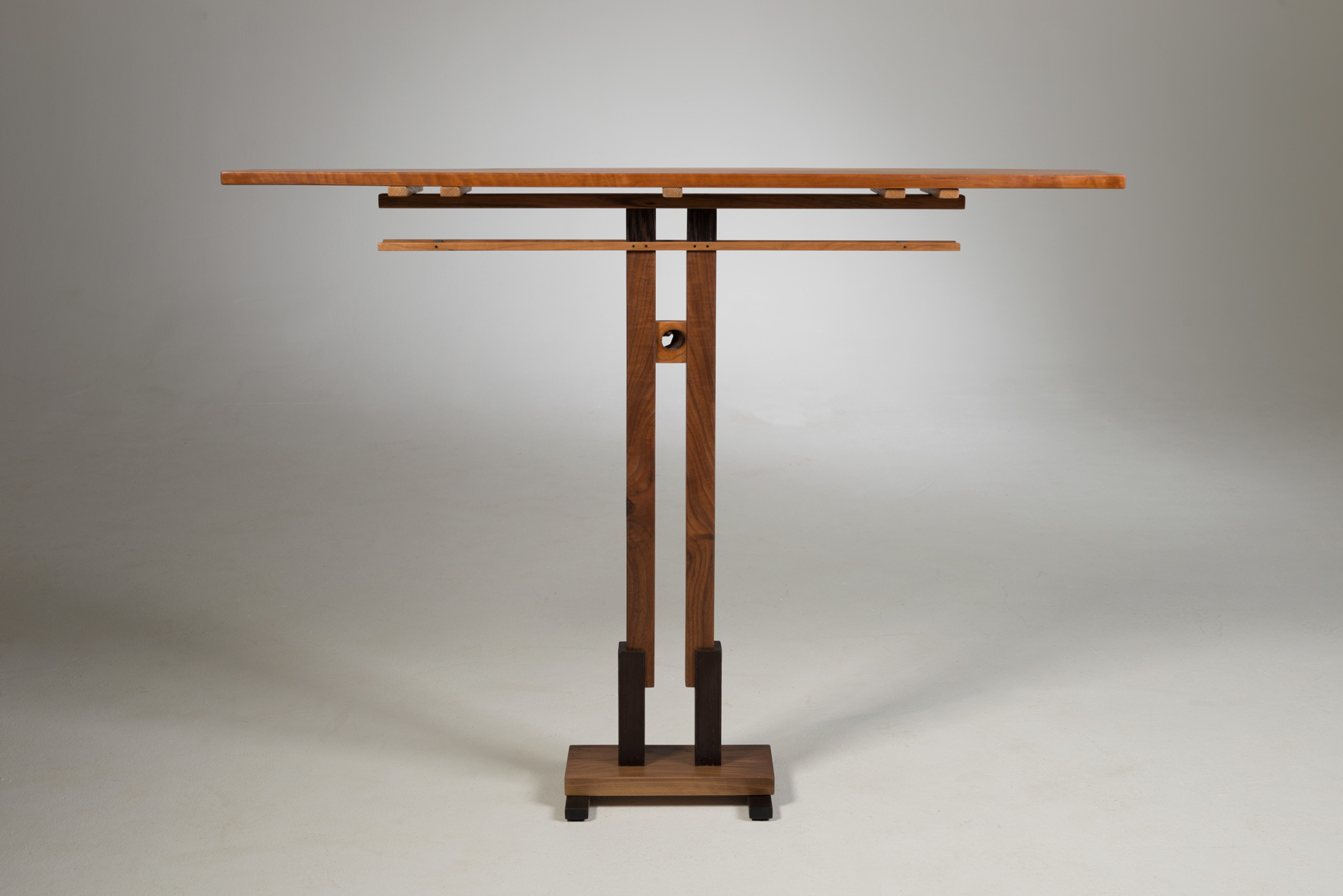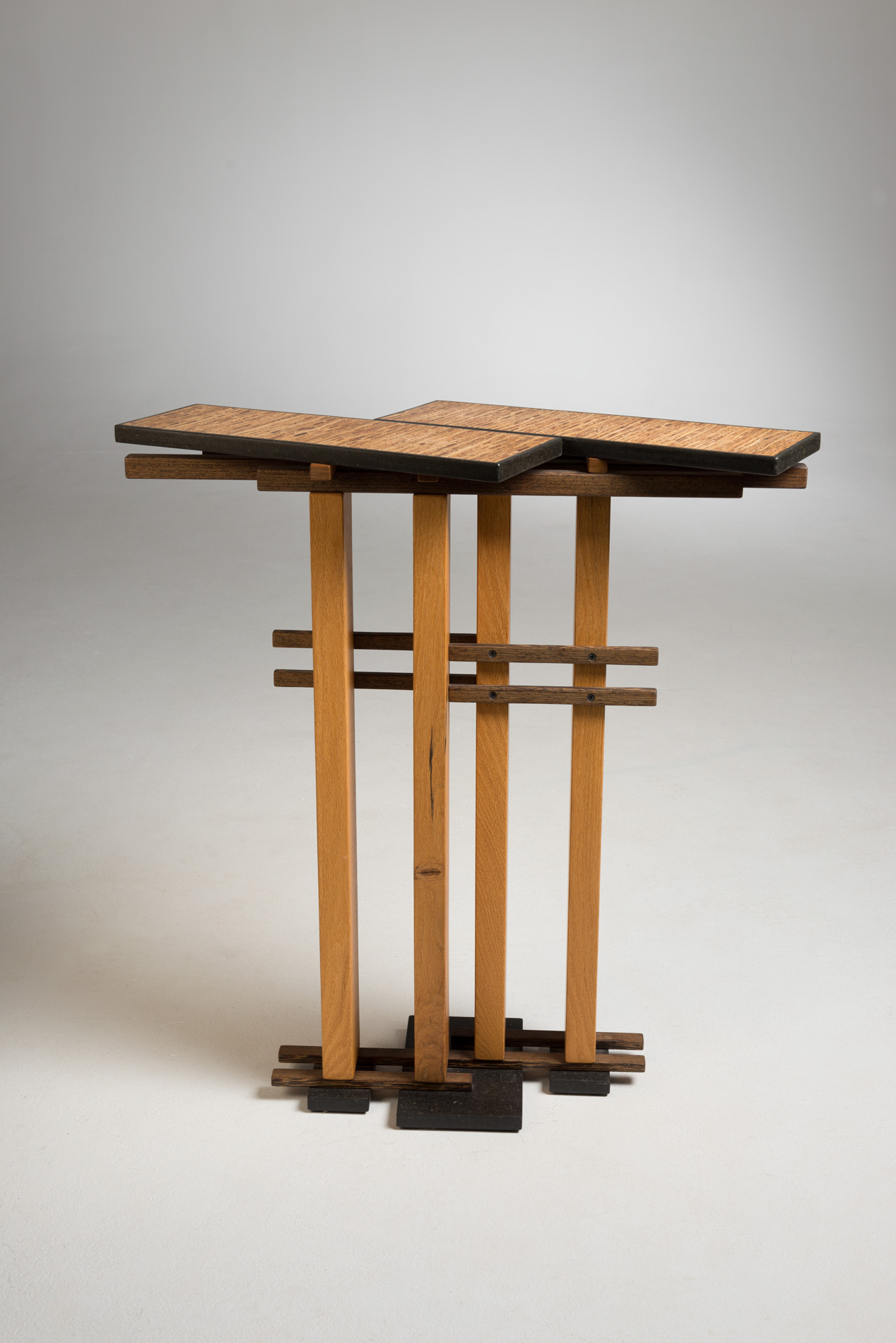Tables
The first serious design pieces that I built were tables. Over time these developed into several types. One series that I called bridgeform were all based on a long narrow template. The designs reflected my fascination with bridges, and they were engineered in the same ways. Some of them were arched, some built as trestles, and some angled and braced with ties. An offshoot of these tables had natural-edged tops, the more formal bases contrasting with those irregular forms. Another series, samurai tables, were also narrow, but taller with a center support holding a shorter, cantilevered top. These tables seemed to be designed to hold a Japanese sword. Again, these show a lot of different solutions to the same basic layout. I have also built a number of dining room tables and conference tables which share the same basic requirements of providing space for seated people. These projects are commissioned pieces, so each solution is unique. They are functional pieces first, not just design exercises. Again, the shape of the top determines the structure and form of the base. In general, I’ve always treated table design as a way to display the wood of the top piece, and in some pieces making the base look as if it was holding the top down rather than holding it up.
This table is an elaboration on the Samurai Table series, in that it retains the narrow cantilevered top. The grid design of the column is reflected in the base and these two elements together give the piece an almost Mondrian-link appearance. Despite its complex construction this piece retains a simplicity of composition.
Grid Table
41h x 43.5w x 9d
Crafted of Zebra Wood, Environ Biocomposite, and Various Woods
2007
This piece retains the basic format of the series—the cantilevered top, but with a more deconstructed base design. I wanted to keep the formal balance of elements within the piece while using the staggered column design and natural center brace to balance the composition.
Samurai table
39h x 51w x 9d
Crafted of Cherry, Walnut, and Bubinga
2013
I was working with a new composite material, Kirei, which, when banded with a black border, reminded me of tatami mats. This brought traditional Japanese architecture to mind, so I built the frame and base in a way that reflected the timber frame construction techniques these buildings traditionally use. I staggered the frame elements and skewed the top panels to break up the otherwise formal regularity of the piece.
This is one of a long series of tables which share in common a narrow cantilevered top supported by a center column. This piece departs from the others in that the top is very irregular in shape. Much longer braces support the top piece. I added asymmetric details to the base to create a sense of non-regular formality while complementing the natural shape of the top.
This is one of a long series of tables which share in common a narrow cantilevered top supported by a center column. This piece departs from the others in that the top is very irregular in shape. Much longer braces support the top piece. I added asymmetric details to the base to create a sense of non-regular formality while complementing the natural shape of the top.
38.5h x 63w x 8d
Crafted of Rosewood, Cardinal Wood, Bubinga, and Wenge
2007
The piece of wood I chose for this table was very highly figured, so I felt that keeping the structure simple would be appropriate. This is a much more contemporary design than most of the tables I’ve built. The arch isn’t structural, but it provides a necessary defining of the space between the vertical supports. This minimalism gives the table an elegantly simple composition.
30h x 108w x 7.5d
Crafted of Mahogany and Maple
2008
I have built a series of long narrow tables over the years, usually starting with a piece of wood that seemed to be perfect for a top and then designing a base that I felt complemented the shape of the piece. In this case the top had an irregular shape, so I created a symmetrical base both to enhance its form and to contrast with the natural edges. I wanted the overall appearance to be very open, so I shifted the visual mass of the piece to the base to maintain a sense of lightness. The look of the finished piece reflects my fondness of Japanese architecture and timber frame construction. This is reinforced by the contrast between the arch and the straight line horizontal and vertical pieces.









